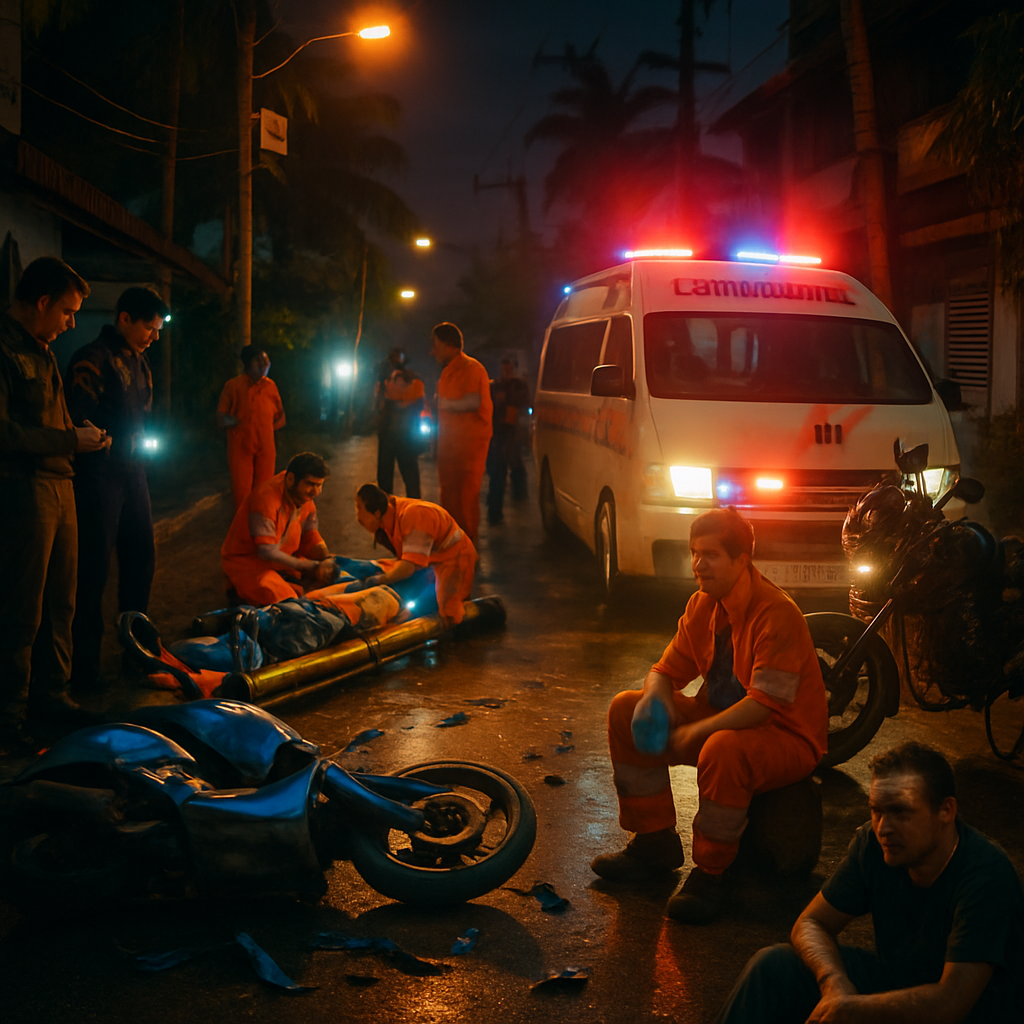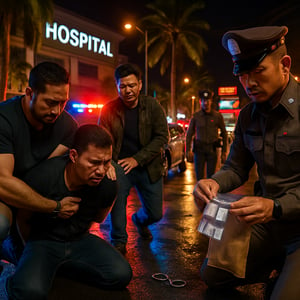Late-night head-on crash in Pattaya leaves one man fighting for life
What began as a routine ride along a quiet Pattaya soi turned into a harrowing nightmare for two motorcyclists late on the evening of November 18. Emergency crews arrived to a scene of shattered plastic, twisted metal and two injured riders after a head-on collision on Soi Nern Plub Wan near the entrance to Mab Yai Lia Soi 39/1.
Rescuers from the Sawang Boriboon Thammasathan Foundation found a blue Honda Wave overturned in the middle of the road, its front end crushed and fragments of the machines scattered across the pavement. The rider of the Honda, 28-year-old Somrak Inthanil, was discovered unconscious and suffering multiple abrasions and severe trauma. Paramedics provided emergency first aid before rushing him to Patmakhun Hospital, where he remains in critical condition.
The second rider, 30-year-old Chakkrit Monthathip, was fortunate to be conscious when responders reached the scene, but he was also injured. Chakkrit had been riding a black Yamaha, which sustained heavy front-end damage in the impact. He was treated at the roadside and later taken to the same hospital for further care.
A local witness, Sirichai Inphuang, told police that Chakkrit had been travelling in his designated lane when Somrak unexpectedly crossed the centre line, leading to the terrifying head-on collision. Officers from Nongprue Police Station have documented the crash site and are now reviewing nearby closed-circuit television footage to reconstruct the moments leading up to the impact. Authorities say legal action will proceed once both riders are stable enough to provide formal statements.
Nighttime risks on narrow sois
Pattaya’s network of sois (side streets) feels intimate and familiar to locals — narrow lanes, sharp turns and a steady mix of foot traffic and two-wheelers. At night, however, these lanes can be treacherous. Reduced visibility, varying speeds, and the occasional sudden manoeuvre create a dangerous mix that can turn an ordinary ride into a life-threatening incident in seconds.
This latest crash is a reminder of how quickly things can go wrong on two wheels. A single moment — a stray swerve, a misjudged overtake, or crossing a centre line — is all it takes for a collision to become catastrophic. Both vehicles in this case show the telltale signs of a high-impact, front-end crash: twisted frames, broken headlights and the kind of debris field that tells rescuers they are dealing with serious injuries.
Emergency crews and the aftermath
The Sawang Boriboon Thammasathan Foundation volunteers and ambulance crews acted swiftly, stabilising the injured riders and clearing the scene for investigators. Their rapid response is often the difference between life and death in these chaotic moments. But as investigation teams sift through CCTV and take witness statements, the community is left to contend with the emotional and practical fallout of such collisions.
Officials say legal proceedings will follow, though those processes will be put on hold until both riders can give coherent statements. In the meantime, Somrak’s family and friends are likely holding vigil at Patmakhun Hospital, hoping for signs of recovery. Chakkrit, while injured, may be able to help police piece together what happened once he’s released from immediate care.
A grim echo: another fatal crash earlier this month
Tragically, this was not the only serious motorcycle incident in Pattaya this month. On November 11, a devastating collision on Sukhumvit Road, heading towards Chon Buri, claimed the lives of two motorcyclists and left another person seriously injured. That crash drew emergency teams from the same Sawang Boriboon Thammasathan Foundation and Bang Lamung Police, underscoring a grim pattern of fatal two-wheeler accidents in the area.
While each crash has its own set of contributing factors, the accumulation of incidents highlights broader concerns about road safety in and around Pattaya — from speeding and lane discipline to the hazards posed by poor lighting and mixed traffic environments.
What can be learned?
There are no easy answers, but awareness and caution go a long way. Riders can reduce risk by keeping to their lane, maintaining a safe speed for the conditions, ensuring headlights and taillights are functioning, and wearing proper protective gear at all times. For motorists and local authorities, improving street lighting, clearer signage and targeted enforcement on high-risk stretches could help reduce the chances of future tragedies.
For now, the community waits for updates on Somrak’s condition as investigators continue their work. When the dust settles and statements are taken, more details may emerge about why a young man crossed a centre line on a quiet Pattaya soi late at night. Until then, the collision stands as a sobering reminder that even familiar streets can turn dangerous in an instant.
If you witnessed the crash or have relevant CCTV footage, Nongprue Police Station has requested that you come forward to assist with the investigation.


















Sounds like classic reckless riding to me — crossing the centre line at night is asking for it. Maybe he was drunk, maybe distracted, but the rider who left his lane caused this. Hope the hospital can save him, but people need to take responsibility.
Not so fast; we don’t know if the road was poorly lit or if there was something in his lane that forced him over. Blaming the injured guy before the investigation is unfair and hurtful to his family.
Fair point about lighting, but even with bad lights you don’t just drift into oncoming traffic. I’ve ridden these sois — drivers swerve all the time. Still, I’ll admit I jumped to conclusions.
Both of you touch on important factors: human error and environmental conditions. Research shows most two-wheeler crashes are multifactorial — impaired visibility, speed, and lane discipline all interact. Policy should address both enforcement and infrastructure.
This is on the city. Narrow sois with no lights are traps for motorbikes. Fix the lighting, put up reflective markers, and ticket people who ride like maniacs — simple.
Throwing money at lights won’t fix stupidity or poor helmet use. Most riders here don’t wear proper gear, and the hospitals see the results. Enforce helmets, not streetlamps.
Helmets are important but they’re already required — enforcement is lax. I’m saying fix the street so mistakes don’t become fatal mistakes. Both measures are needed.
I’ve seen cops on busy roads but not in these sois. Small investment in patrols and lights would likely reduce crashes a lot, especially after dark.
From a public health perspective, repeated incidents in the same area indicate systematic issues. We need data-driven interventions: hotspots, targeted enforcement, community education and improved lighting. Quick fixes won’t work without sustained policy.
Data sounds nice, but who’s going to pay? People survive on small incomes and ride risky because they have no alternatives. Blaming infrastructure ignores poverty.
Cost is real, but the economic toll of injuries and deaths also burdens families and the health system. Investments in safety can be cost-effective if targeted properly.
Agree with Dr. Priya — prevention saves money and lives. But you also need community buy-in, otherwise rules feel imposed and get ignored.
Courts should make examples. If you drive or ride like you’re untouchable, lose your license or face harsher penalties. Too many repeat offenders just get a slap on the wrist.
Harsh penalties without proper checks hurt the poor more. Many riders are daily laborers who depend on their bikes. Penalize the behavior, yes, but give education and options first.
Education is fine, but talk is cheap. Without real consequences people won’t change. We need both — training and enforcement.
I can’t stop thinking about Somrak’s family waiting at the hospital. The article made me feel sick; what if it was my brother? We sensationalize crashes but rarely talk about grieving families.
Media does sensationalize, yes, but reporting can also prompt change. If stories like this push the council to act, maybe some good comes from the pain.
I hope so, but action has to be timely. People are tired of promises after headlines fade. The community needs real, lasting measures, not empty speeches.
If anyone has CCTV, come forward like the police asked. Community footage often makes the difference in these cases and can lead to quicker responses.
Wait until the investigators get their hands on the footage. Stories like this always get complicated — sometimes corruption slows justice, sometimes witnesses lie. Don’t assume guilt yet.
Are you saying the police will cover it up? That’s cynical and dangerous. People deserve transparency, not conspiracies.
I’m saying be realistic. Systems have flaws. Public pressure helps, but blind accusations don’t fix anything.
Bad drivers and bad roads. That’s why my mom says never ride at night. Simple lesson every kid should learn.
Kids learn from examples, not just rules. If adults flout safety all the time, telling kids ‘don’t ride at night’ won’t solve systemic risk. We need role models and enforcement.
Okay, but still — wear a helmet and don’t drive crazy. My school taught that and it makes sense.
Practical steps: reflective lane markings, speed bumps at certain chokepoints, and free checks for headlights at community centers. Small things that are cheap but effective.
Free checks would be great. Many riders don’t know their lights are dim or their brakes are bad until it’s too late. Community workshops could help.
Exactly. Empower riders with info and basic maintenance skills — it could prevent a lot of crashes.
I’ve been tracking crashes in this area for months; there’s a cluster near Soi 39/1 after dark. CCTV often shows near-misses before the big one. Authorities need to act on patterns, not headlines.
If you’ve got a log, hand it to the police unit. Patterns are useful, but official evidence prompts resource allocation. Activists can support the case with documented records.
I submitted a summary to the municipal office last year but got a generic reply. Maybe with public attention they’ll actually prioritize it.
Tragic. These incidents remind us life can change in a second. Policy debates aside, someone is in a hospital fighting for life and families are grieving.
True, personal stories often catalyze policy change. We need to balance compassion for victims with systematic prevention to reduce future tragedies.
Hopefully this story leads to both: better support for victims and stronger preventative measures.
You can’t treat traffic like a game. I lost a cousin to a careless swerving driver last year; it’s a trauma that follows families for life. Enforcement must be consistent.
Consistent enforcement is a dream when resources are scarce. Better to push for low-cost changes like reflective paint and community awareness, which are more feasible.
I agree low-cost fixes help, but they can’t replace proper policing. Both are necessary — infrastructure and enforcement go hand in hand.
I worry about how news reports can stigmatize victims. Somrak might be portrayed as a ‘reckless rider’ before we know the facts. Media responsibility matters.
Media does rush, but readers also tend to assume guilt from accidents. We should all reserve judgement until official statements are out.
Exactly. Especially when families are reading the comments — basic human decency would go a long way.
Also, why do people ride at crazy speeds at night in sois? This culture of showing off on bikes needs to stop. Peer pressure and macho attitudes kill.
Shaming ‘macho’ culture helps, but it’s not the whole story. Mental health, alcohol, poor lighting, and equipment failure all play roles. Simplifying it to macho posturing is lazy.
I’m not simplifying — I’m pointing out a real behavioral factor that’s often ignored. Address culture and infrastructure together.
If CCTV shows someone forced over the line by a pothole or parked car, would public opinion change? We rush to blame but don’t always consider micro-environmental hazards.
Yes, micro-hazards matter. I’ve seen riders swerve to avoid cameras, scooters, and even dogs. Fixing those small problems reduces risky maneuvers considerably.
Then the focus should be maintenance and removing clutter from narrow roads, not just more fines.
We should consider systemic interventions like graduated licensing for young riders, mandatory night-time reflective clothing, and subsidized helmet programs. Evidence supports multi-pronged approaches.
Subsidies sound expensive, but if they reduce hospital loads it’s probably worth it. I’m open to smart incentives rather than just punishments.
Exactly — incentives plus enforcement tend to work better than either alone. Pilot programs in hotspot sois could test cost-effectiveness.
I volunteer with the Sawang Boriboon team and we see so many preventable injuries. Quick response helps but prevention is the real game-changer. Please wear reflective vests at night.
Thanks for volunteering, that’s really brave work. I will tell my friends to wear vests.
Small actions spread — if each rider wears a vest, the community becomes safer. Gratitude is appreciated from the rescue side.
Why are two people riding so late? Nightlife and drinking culture play a role here. Maybe nightlife hours or services need regulation to protect riders.
Regulating nightlife is controversial and could harm businesses. Better to focus on responsible service and ride-home alternatives like affordable taxis.
Alternatives like safe rides are a better, less punitive approach. Subsidized late-night transport would save lives without killing the economy.
One more practical note: witnesses often forget crucial details unless interviewed quickly. If you saw anything, give police a statement now while memories are fresh.
Good reminder. Memories fade and the story can get muddled. I’ll ask my neighbor if they saw anything and encourage them to report.
Thanks — community cooperation can make investigations faster and more accurate.